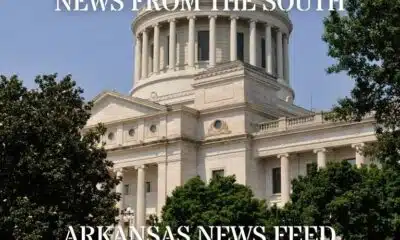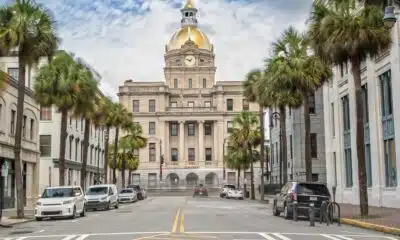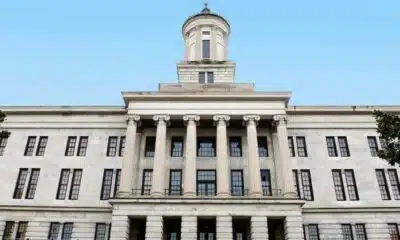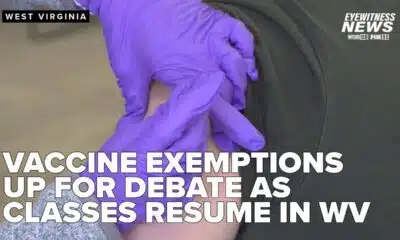News from the South - Louisiana News Feed
Louisiana Living: Vaughn Toyota
SUMMARY: In a recent segment, Chelsea Allen from Von Toyota, Fire Chief Timothy Williams of the Bastrop Fire Department, and Elmore Patterson, CEO of Morehouse General Hospital, discussed their annual toy drive aimed at assisting less fortunate children in Morehouse Parish. Initiated 11 years ago, the drive has provided Christmas gifts to over 1,500 children. Morehouse General joined this year to further support community needs. The fire department helps gather donations and delivers toys, sometimes even involving Santa Claus. Members of the public can contribute toys or monetary donations at designated locations. This year, they hope to assist around 150 children.
Louisiana Living: Vaughn Toyota
News from the South - Louisiana News Feed
LUS reverses course on coal power plant closure – The Current
SUMMARY: Lafayette Utilities System (LUS) planned to retire the coal-burning Rodemacher 2 power plant by 2027, but rising power demand and construction delays at the new Bonin natural gas plant (now expected by 2029) have changed this. The Lafayette Public Power Authority voted to pursue $95 million in bonds to renovate or convert Rodemacher 2, potentially extending its life. Options include converting to natural gas, upgrading to meet wastewater compliance, or maintaining the plant as is. Though costly renovations were once avoided, market conditions now make keeping Rodemacher 2 operational advantageous to meet energy needs and maximize market value.
The post LUS reverses course on coal power plant closure – The Current appeared first on thecurrentla.com
News from the South - Louisiana News Feed
Transgender Louisianians on Medicaid being denied coverage for gender-affirming care
by Drew Costley, Verite, Louisiana Illuminator
August 22, 2025
But when she got to the pharmacy, she learned that her medication was going to cost approximately $70.
But it wasn’t a surprise. Green had been expecting Medicaid — which is mostly federally funded but administered by the state — to stop covering her hormone replacement therapy, a common form of gender-affirming health care. For nearly a year, she and other trans advocates in Louisiana had heard about sudden, unexpected Medicaid denials from dozens of transgender people around the state.
Whatever happened, it wasn’t a change to Medicaid law. Earlier this year, Congress contemplated stripping gender-affirming care coverage as part of President Trump’s sweeping tax and spending bill, known as the “One Big Beautiful Bill Act.” But the provision didn’t make the final version passed by the Senate in early July.
GET THE MORNING HEADLINES.
State lawmakers over the past several years have passed a wave of anti-trans and anti-LGBTQIA+ legislation, including banning doctors from providing gender-affirming care to minors. So Green and other trans advocates had been watching the state legislature closely, anticipating movement to prohibit Medicaid from covering gender-affirming care for adults. That didn’t happen, either.
That likely meant that there had been an administrative change from the Louisiana Department of Health, which oversees Medicaid. But there had been no notice of any such change from the state department.
“The only way a lot of people are learning about this is that they’re going into the pharmacy to pick up their monthly or once every three months…regular prescriptions that they’ve been on for a long time, and just getting hit with a completely unexpected bill,” Green said. “Because there’s been no communication from the state about this.”
The Louisiana Department of Health did not respond to Verite News’ requests for comment on the denials of Medicaid coverage for gender-affirming care for adults and why the denials are happening. But LDH records reviewed by Verite show that the department has made changes to its Medicaid billing and diagnosis codes so that gender-affirming surgeries and hormone therapy are excluded from coverage. The changes appear to have started in August 2024.
As a result, people have been cancelling surgeries they’d been waiting years to get and trying to find other ways to afford their medications, Green told Verite News. Without coverage, these surgeries and medications can cost hundreds or thousands of dollars.
Nationally, between 20% and 25% of transgender adults are enrolled in Medicaid, according to recent estimates.
While there are no readily available data on how many transgender people in Louisiana are enrolled in the public insurance program, the state as a whole has the second highest share of Medicaid-enrolled residents, according to data from the Kaiser Family Foundation.
“Many trans people only have access to Medicaid coverage, I’m one of them. [It] definitely is very scary,” said Blu DiMarco, who works with the Queer and Trans Community Action Project. “It’s frightening to know that I could just, like, go to routinely pick up my medication, and they could be like, ‘Oh yeah, this is $200.’ I don’t have $200.”
Community care, collective rage
In response to the LDH policy change, the Trans Income Project, a New Orleans-based social services nonprofit, this month announced a partnership with CrescentCare, a clinic that primarily serves low-income residents. The Trans Income Project, on which Green serves as a board member, will cover the cost of medication used in hormone replacement therapy for Medicaid-eligible transgender adults. (Participants in the partnership have to get their medication from the Avita Pharmacy locations inside of CrescentCare’s Elysian Fields and Mid-City facilities.)
Natalie Rupp, executive director of the Trans Income Project, told Verite News that the organization “saw a serious need in the community” when they began hearing about people losing Medicaid coverage for gender-affirming care.
“We’re trying to make sure that those most vulnerable in our community aren’t going to be stuck with additional extra costs that they previously weren’t having to cover,” she said.
The program has been praised by other trans advocacy organizations in Louisiana as an example of people coming together to support those most in need and fight back against anti-transgender policies.
“It’s a really great show of community force and how community will take care of community, even when politicians aren’t taking care of community,” Peyton Rose Michelle, executive director of Louisiana Trans Advocates said.
Rupp said she hopes that healthcare providers and pharmacies in other parts of the state and country replicate the partnership at a time when governments are moving to limit access to gender-affirming care for trans and gender nonconforming people. Eleven other states already explicitly prohibit Medicaid from funding gender-affirming care for both adults and minors.
Although it’s located in New Orleans, Crescent Care serves transgender Louisianians throughout the state, so the hope is that people outside of the metropolitan area will be able to make use of the partnership as well. Michelle said that she knows people in Lafayette, where she lives, who use CrescentCare.
Still, it’s unlikely that the partnership will be able to cover everyone who loses access to hormones as a result of the LDH coding changes, and there’s still the question of how people who need gender-affirming surgeries, which are not covered under the partnership, will afford that care.
“I think even the organizers of their beautiful plan to provide care via Avita,” Michelle said. “I think even those people understand this isn’t going to save everyone. It is just a band aid kind of solution that will only help a subset of people.”
In order to further raise awareness about the state’s decision to stop covering gender-affirming care through Medicaid and express anger about it, the Queer and Trans Community Action Project is holding a protest Saturday at New Orleans City Hall. The Louisiana Department of Health has an office about a block away on Poydras Street that protestors will march by. The march and rally starts at 5 p.m.
“I think that the issue is not very well-known, and I think that is a very important issue to note, even for people who aren’t queer or trans, because it’s kind of a larger indicator of Medicaid cuts,” DiMarco said. “If they can come for us, then how do you know that you’re not next?”
Madhri Yehiya contributed to this report.
YOU MAKE OUR WORK POSSIBLE.
This article first appeared on Verite News New Orleans and is republished here under a Creative Commons Attribution-NoDerivatives 4.0 International License. PARSELY = { autotrack: false, onload: function() { PARSELY.beacon.trackPageView({ url: “https://veritenews.org/2025/08/21/louisiana-transgender-care-medicaid-denial/”, urlref: window.location.href }); } }
Louisiana Illuminator is part of States Newsroom, a nonprofit news network supported by grants and a coalition of donors as a 501c(3) public charity. Louisiana Illuminator maintains editorial independence. Contact Editor Greg LaRose for questions: info@lailluminator.com.
The post Transgender Louisianians on Medicaid being denied coverage for gender-affirming care appeared first on lailluminator.com
Note: The following A.I. based commentary is not part of the original article, reproduced above, but is offered in the hopes that it will promote greater media literacy and critical thinking, by making any potential bias more visible to the reader –Staff Editor.
Political Bias Rating: Left-Leaning
This content focuses on the challenges faced by transgender individuals in Louisiana regarding access to gender-affirming healthcare, highlighting Medicaid coverage cuts and state-level anti-trans legislation. It emphasizes the negative impact of these policies on marginalized communities and features voices from trans activists and advocacy groups. The framing is sympathetic to transgender rights and critical of conservative state policies, which aligns with a left-leaning perspective on social and healthcare issues.
News from the South - Louisiana News Feed
Hurricane Erin floods coastal North Carolina plus 3 other potential tropical formation spots
SUMMARY: Hurricane Erin, a large Category 2 storm with 100-mph winds, is located 260 miles east of Cape Hatteras, NC, moving north-northeast at 18 mph. Hurricane-force winds extend 105 miles from its center, with tropical-storm-force winds reaching 320 miles. The National Hurricane Center forecasts Erin to weaken and become post-tropical by Saturday as it moves between the U.S. East Coast and Bermuda, then south of Atlantic Canada. Storm surge warnings remain for parts of North Carolina, with tropical storm warnings and watches for Virginia and Bermuda. Erin brings dangerous surf, rip currents, and flooding risks. Multiple other tropical disturbances in the Atlantic show potential for development.
Read the full article
The post Hurricane Erin floods coastal North Carolina plus 3 other potential tropical formation spots appeared first on wgno.com
-
News from the South - Texas News Feed5 days ago
New Texas laws go into effect as school year starts
-
News from the South - Florida News Feed5 days ago
Floridians lose tens of millions to romance scams
-
News from the South - Kentucky News Feed6 days ago
AmeriCorps is under siege. What happens in the communities it serves?
-
News from the South - Florida News Feed6 days ago
Protesters go on strike in Israel demanding ceasefire and release of Gaza hostages
-
News from the South - Missouri News Feed7 days ago
Three months since St. Louis tornado: How long will cleanup take?
-
News from the South - West Virginia News Feed5 days ago
Religious exemption debate front and center amid new school year in WV
-
News from the South - Alabama News Feed5 days ago
Final steel girders placed on new Gulf Shores bridge, completion on track
-
News from the South - Tennessee News Feed6 days ago
Son hopes to get emergency visa following mother's death in East Tennessee












































